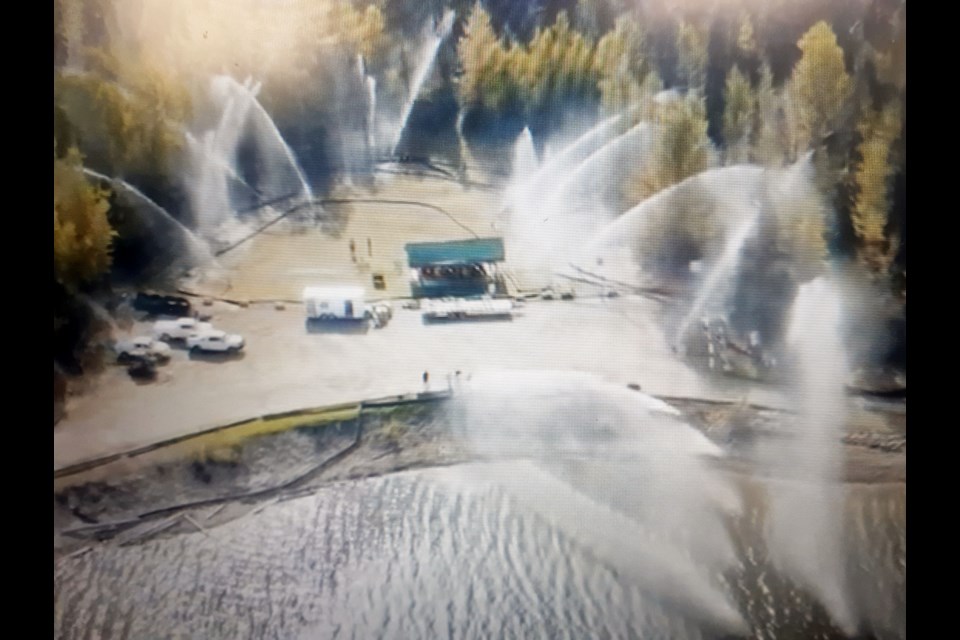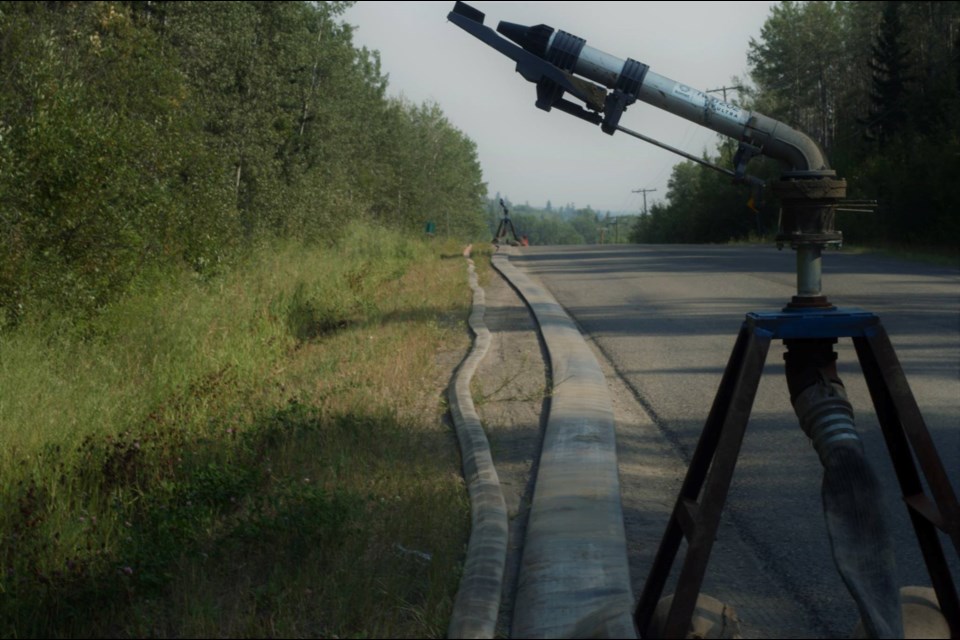Mass water deployment seen as cost-effective method of dousing wildfires to protect towns from destruction
about 10 hours ago By: Ted Clarke



Safeguard, a wildfire fighting company based in Fort St. John, demonstrates how it uses its high-powered pumps and hoses to create a water curtain as a means to protect towns from destruction in wildfires. MLA Mike Morris says it's time the province declared a state of emergency to get resources like Safeguard involved in fighting the fires in B.C.Safeguard website
Jeff Kelly is no weather god but he does have the ability to make it rain.
Kelly owns and operates Safeguard, a Fort St. John-based emergency response company that specializes in cost-effective mass water deployment as a means of dousing wildfires, especially in instances where towns are threatened. The company’s innovative firefighting system utilizes powerful pumps and manifolds that draw vast amounts of water from lakes and rivers to feed high-pressure water cannons which can soak forested areas or buildings.
“We can employ enough water cannons to do a 20-kilometre water curtain that is 200 feet high by 320 feet wide,” said Kelly. “Each system will pump 3,000 feet and we put multiple systems beside each other. In our Fort St. James dispatch (fighting the Shovel Lake fire in 2018) we had seven systems to do a 10-kilometre curtain. Each of these systems will pump 7.6 million gallons of water in 24 hours.
“Where mass water shines is when you have immediate access to a lot of water, you have good enough road access to pull the semi trucks right up where you deploy. One of our pumps can push water to 700 fire hoses. Where you would need 700 little Mark 3 pumps, we can take over the whole fire and we can provide it 24/7, more pressure, more volume.”
During times when not much water is needed on the fire, the pumps can be used to fill holding tanks or structural protection and create water supplies for fire trucks or sprinklers.
Safeguard employs a full-time staff of nine and Kelly says he has 210 firefighters trained and ready to go, with contractors available to back them up. Knowing there is dry lightning in the forecast for the Okanagan region early this week, Peters has moved with some of his equipment to Vernon, where he awaits word from the BC Wildfire Service if and when he and his crews will get hired.
“We have 300 active fires (in B.C.), 11 new in the last 48 hours,” Kelly said Monday. “There’s dry lightning coming and very little precipitation. The indices that indicate fire danger are some of the worst that we’ve seen in a long time. We’re into season-end indices where things typically dry out and it gets worse and worse - we’re there already.’
In a July 12 BC Wildfire Service update letter sent to forest industry leaders, Rob Schweitzer, director of fire operations for the Kamloops Fire Centre, said the hot, dry weather is expected to continue for the next two months and with the province dealing with as many as 45 new fires every day, the Wildfire Service will need every available resource within its own ranks as well as industry support and assistance. The BCWS is also asking forestry companies to fight fires independently because there are not enough Wildfire Service staff to do the job.
The BCWS has approached the BC Cattlemen’s Association and Indigenous communities for equipment and other resources and has engaged the military to assist in mop-up operations. The letter states there’s no additional help expected from other provinces and no movement of resources expected. Alberta and Ontario are dealing with their own wildfires, as are the Pacific Northwest states.
Internationally, Australia has traditionally helped fight BC wildfires but due to COVID-19 restrictions which require two-week isolation periods in a hotel for Australians returning to that country, there is a backlog of 20,000 people on the wait list and the Australian government is not prioritizing firefighters. A group of about 100 firefighters from Mexico is due to arrive later this week to assist in ground suppression efforts. Each of them requires vaccinations and it will be two weeks upon arrive before they can work. Schweitzer warned the forest companies there is very little air support available to them and that the Wildfire Service is prepared to rent firefighting equipment from them if they are not using it.
Safeguard’s water curtain crews have been dispatched three times by the B.C. government to fight fires (Elephant Hill fire in 2017, Shovel Lake and Burns Lake fires in 2018). But so far this year, they have yet to be deployed.
Kelly feels an attachment to his home province and can’t understand why the BC Wildfire Service, facing one of its worst-ever fire seasons, has not yet asked his company to join in the fight. His water cannon system costs one cent per gallon of water to operate, compared to the $3 per gallon it costs to use a water bomber to dump its load on a flaming forest.
“The province says they are using resources all across Canada and now they’re bringing in worldwide resources, yet we have millions of dollars of resources and professional people waiting in Fort St. John,” said Kelly.
“The wheels of change and innovation in government turn ever so slowly. This is something new. I hope they will see the value in what we’re offering.”
Safeguard’s water intake equipment is heavy and requires semitrailer or skid-steer road access to move it close to water supplies. The equipment can be positioned with two crew members on standby for $5,000 per day and $10,000 per day when operating with a full crew. Considering air tankers for fighting fires can cost up to $8,000 per hour, Kelly says his company’s services are extremely cost effective.
“The idea is to get the equipment in the hot zones, because it can save 24 hours of deployment time,” he said. “Once we get started, assuming the access is really good, in most case we’re down to 12-hour deployment. But we need to get the equipment there and the people there first.
”Other than the hose and the pumps, everything we have is hand-portable, which has drastically reduced the rollout time. Typically you don’t have more than 72 hours notice to roll one of these systems out. It’s hard to predict what a fire’s going to do beyond three days.”
A veteran firefighter of 38 years, for Kelly it started when he was 14, battling forest fires. That continued into adulthood and he spent 15 years on oilfield fire suppression crews and 11 years with the Fort St. John/Taylor Fire Departments. That gave Kelly a thorough understanding of the science behind fires and he knows how to put them out. The company’s ability to conduct risk assessments is critical when rolling out the equipment properly to maintain the safety of the crews and Kelly hires staff who have the experience in government and emergency services to make those decisions.
Kelly started Safeguard in 1994 to serve the oil and gas and forestry industries. The company ramped up its operations six years ago and now has $2 million worth of equipment to maintain its mass water deployment capabilities. He employs environmental experts to ensure the crews don’t draw too much water to protect fish stocks and cause minimal impact and to make sure the proper screens are in place to prevent fish from being sucked into the 12-inch water lines. Engineers are required to safely connect the massive pumps together.
“The firefighters are praying for water right now and we can provide that water through our water cannons,” sad Kelly. “We can literally create rain, mechanically. At risk of oversimplifying the process, more water equals less fire and wet fuels don’t burn. For the first time ever, we can mechanically stop a major Rank 6 wildfire.”
Kelly says there’s no denying climate change has worsened B.C. fire seasons, making them longer and more intense.
“Thirty years ago we were looking at one every seven season being an extreme fire season and now every second season on average is an extreme fire season,” he said.
— Prince George Citizen
Jeff Kelly is no weather god but he does have the ability to make it rain.
Kelly owns and operates Safeguard, a Fort St. John-based emergency response company that specializes in cost-effective mass water deployment as a means of dousing wildfires, especially in instances where towns are threatened. The company’s innovative firefighting system utilizes powerful pumps and manifolds that draw vast amounts of water from lakes and rivers to feed high-pressure water cannons which can soak forested areas or buildings.
“We can employ enough water cannons to do a 20-kilometre water curtain that is 200 feet high by 320 feet wide,” said Kelly. “Each system will pump 3,000 feet and we put multiple systems beside each other. In our Fort St. James dispatch (fighting the Shovel Lake fire in 2018) we had seven systems to do a 10-kilometre curtain. Each of these systems will pump 7.6 million gallons of water in 24 hours.
“Where mass water shines is when you have immediate access to a lot of water, you have good enough road access to pull the semi trucks right up where you deploy. One of our pumps can push water to 700 fire hoses. Where you would need 700 little Mark 3 pumps, we can take over the whole fire and we can provide it 24/7, more pressure, more volume.”
During times when not much water is needed on the fire, the pumps can be used to fill holding tanks or structural protection and create water supplies for fire trucks or sprinklers.
Safeguard employs a full-time staff of nine and Kelly says he has 210 firefighters trained and ready to go, with contractors available to back them up. Knowing there is dry lightning in the forecast for the Okanagan region early this week, Peters has moved with some of his equipment to Vernon, where he awaits word from the BC Wildfire Service if and when he and his crews will get hired.
“We have 300 active fires (in B.C.), 11 new in the last 48 hours,” Kelly said Monday. “There’s dry lightning coming and very little precipitation. The indices that indicate fire danger are some of the worst that we’ve seen in a long time. We’re into season-end indices where things typically dry out and it gets worse and worse - we’re there already.’
In a July 12 BC Wildfire Service update letter sent to forest industry leaders, Rob Schweitzer, director of fire operations for the Kamloops Fire Centre, said the hot, dry weather is expected to continue for the next two months and with the province dealing with as many as 45 new fires every day, the Wildfire Service will need every available resource within its own ranks as well as industry support and assistance. The BCWS is also asking forestry companies to fight fires independently because there are not enough Wildfire Service staff to do the job.
The BCWS has approached the BC Cattlemen’s Association and Indigenous communities for equipment and other resources and has engaged the military to assist in mop-up operations. The letter states there’s no additional help expected from other provinces and no movement of resources expected. Alberta and Ontario are dealing with their own wildfires, as are the Pacific Northwest states.
Internationally, Australia has traditionally helped fight BC wildfires but due to COVID-19 restrictions which require two-week isolation periods in a hotel for Australians returning to that country, there is a backlog of 20,000 people on the wait list and the Australian government is not prioritizing firefighters. A group of about 100 firefighters from Mexico is due to arrive later this week to assist in ground suppression efforts. Each of them requires vaccinations and it will be two weeks upon arrive before they can work. Schweitzer warned the forest companies there is very little air support available to them and that the Wildfire Service is prepared to rent firefighting equipment from them if they are not using it.
Safeguard’s water curtain crews have been dispatched three times by the B.C. government to fight fires (Elephant Hill fire in 2017, Shovel Lake and Burns Lake fires in 2018). But so far this year, they have yet to be deployed.
Kelly feels an attachment to his home province and can’t understand why the BC Wildfire Service, facing one of its worst-ever fire seasons, has not yet asked his company to join in the fight. His water cannon system costs one cent per gallon of water to operate, compared to the $3 per gallon it costs to use a water bomber to dump its load on a flaming forest.
“The province says they are using resources all across Canada and now they’re bringing in worldwide resources, yet we have millions of dollars of resources and professional people waiting in Fort St. John,” said Kelly.
“The wheels of change and innovation in government turn ever so slowly. This is something new. I hope they will see the value in what we’re offering.”
Safeguard’s water intake equipment is heavy and requires semitrailer or skid-steer road access to move it close to water supplies. The equipment can be positioned with two crew members on standby for $5,000 per day and $10,000 per day when operating with a full crew. Considering air tankers for fighting fires can cost up to $8,000 per hour, Kelly says his company’s services are extremely cost effective.
“The idea is to get the equipment in the hot zones, because it can save 24 hours of deployment time,” he said. “Once we get started, assuming the access is really good, in most case we’re down to 12-hour deployment. But we need to get the equipment there and the people there first.
”Other than the hose and the pumps, everything we have is hand-portable, which has drastically reduced the rollout time. Typically you don’t have more than 72 hours notice to roll one of these systems out. It’s hard to predict what a fire’s going to do beyond three days.”
A veteran firefighter of 38 years, for Kelly it started when he was 14, battling forest fires. That continued into adulthood and he spent 15 years on oilfield fire suppression crews and 11 years with the Fort St. John/Taylor Fire Departments. That gave Kelly a thorough understanding of the science behind fires and he knows how to put them out. The company’s ability to conduct risk assessments is critical when rolling out the equipment properly to maintain the safety of the crews and Kelly hires staff who have the experience in government and emergency services to make those decisions.
Kelly started Safeguard in 1994 to serve the oil and gas and forestry industries. The company ramped up its operations six years ago and now has $2 million worth of equipment to maintain its mass water deployment capabilities. He employs environmental experts to ensure the crews don’t draw too much water to protect fish stocks and cause minimal impact and to make sure the proper screens are in place to prevent fish from being sucked into the 12-inch water lines. Engineers are required to safely connect the massive pumps together.
“The firefighters are praying for water right now and we can provide that water through our water cannons,” sad Kelly. “We can literally create rain, mechanically. At risk of oversimplifying the process, more water equals less fire and wet fuels don’t burn. For the first time ever, we can mechanically stop a major Rank 6 wildfire.”
Kelly says there’s no denying climate change has worsened B.C. fire seasons, making them longer and more intense.
“Thirty years ago we were looking at one every seven season being an extreme fire season and now every second season on average is an extreme fire season,” he said.
— Prince George Citizen
No comments:
Post a Comment